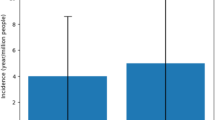Abstract
An investigation was made into some of the major sources of error influencing the bone mineral density (BMD) measurements of the lumbar vertebrae, the femoral neck and the greater trochanter. The effect on accuracy and reproducibility of the following parameters was investigated: influence of patient positioning, patient size, scan speed, the technique of scan analysis and the temporal variation in instrument performance.
The in vitro precision, both long-term and short-term, was assessed using aluminium phantoms supplied by the manufacturer. For the spine phantom, the precision expressed as a percentage coefficient of variation (%CV) was found to be 0.4% (10 scans) in the short term and 0.55% (15 scans) in the long term. Measured precision (short-term) for the three regions of the femur phantom analysed by the software was 1.3% for the neck of femur, 1.7% for Ward's triangle and 0.6% for the trochanter. Long-term precision was 1.0%, 1.9% and 1.1% respectively. No statistically significant difference was found between long- and short-term results.
Short-term in vitro precision on a low density anthropological phantom was 4.1%, 4.2%, 2.4% and 0.61% for neck of femur, Ward's triangle, trochanter and spine respectively.
In vivo short-term precision for the lumbar spine (L2–L4), measured by scanning four normal volunteers five times in one session, was found to be 0.8±0.25%. In vivo precision for the femur, measured on seven volunteers was 1.6±0.8% for the neck of femur, 3.2±1.7% for Ward's triangle and 2.2±1.1% for the trochanter.
The variation in density results caused solely by analysis was investigated by analysing ten randomly selected normal femoral scans five times on five different days. Again results are expressed as a coefficient of variation and were 1.3±0.8% for the neck of femur, 2.4±1% for Ward's triangle and 0.8±0.7% for the trochanter, suggesting that most of the variation in the femur density results can be attributed to the analysis procedure.
Similar content being viewed by others
References
A Report of the Royal College of Physicians, Prevention and Management of Osteoporosis. The Royal College of Physicians 1989.
Fogelman I. An evaluation of the contribution of bone mass measurements to clinical practice. Semin Nucl Med 1989; 19:62–8.
Fogelman I, Rodin A, Blake G. Impact of bone mineral measurements on osteoporosis. Eur J Med 1990; 16:39–52.
Cummings S, Black D. Should perimenopausal women be screened for osteoporosis? Ann Intern Med 1986; 104:817–23.
Tothill P. Methods of bone mineral measurement. Phys Med Biol 1989; 34(5):543–72.
Stevenson JC, Whitehead MI. Postmenopausal osteoporosis. BMJ 1982; 285:585–8.
Wahner H, Dunn M, Brown M, Hansen M, Morris R. Comparison of quantitative digital radiography (QDR) and dual photon absorptiometry (DPA) for bone mineral measurements of the L-spine. In: Dequeker JV, Geusens P, Wahner H, eds. Bone mineral measurement by photon absorptiometry. Leuven University Press, Leuven, 1986; 419–26.
Pacifici R, Rupich I, Fischer, Griffin, M. Dual energy radiography (DER): A preliminary comparative study. Calcif Tissue Int. 1988; 43:189–91.
Gluer C, Steiger P, Selvidge R, Elliesen-Kliefoth K, Hayashi R, Genant H. Comparative study of dual-photon absorptiometry and dual-energy radiography. Radiology 1990; 174:223–8.
Hall ML, Heavens J, Cullum BA, Ell PJ. The range of bone density in normal British women. B J Radiol 1990; 63:266–9.
Mazess R, Collick B, Trempe J, Barden H, Hanson J. Performance evaluation of a dual-energy X-ray bone densitometer. Calcif Tissue Int 1989; 44: 228–37.
Braillon A, Duboeuf F, Meary MF, Barret P, Delmas PD, Meunier PJ. Measure du contenu minéral osseux par radiographie digitale quantitative. Premiers résultat au niveau vertébral lombaire. Presse Med 1989; 18:1062–5.
Kelly TL, Slovik DM, Schoenfeld DA, Neer RM. Quantitative digital radiography versus dual photon absorptiometry of the lumbar spine. Med Phys 1989; 16(l):75–80.
Leichter I, Bivas A, Giveon A, Margulies JY, Weinreb A. The relative significance of trabecular and cortical bone density as a diagnostic index of osteoporosis. Phys Med Biol 1987; 32(9):1167–74.
Armitage P, Berry G. Statistical methods in medical research, 2nd edn. Oxford: Blackwell Scientific Publications, 1987.
Author information
Authors and Affiliations
Rights and permissions
About this article
Cite this article
Lilley, J., Walters, B.G., Heath, D.A. et al. In vivo and in vitro precision for bone density measured by dual-energy X-ray absorption. Osteoporosis Int 1, 141–146 (1991). https://doi.org/10.1007/BF01625443
Received:
Accepted:
Issue Date:
DOI: https://doi.org/10.1007/BF01625443




